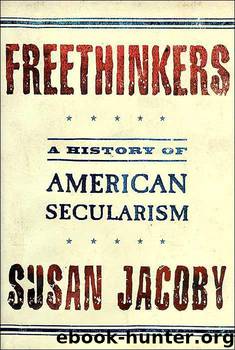Freethinkers: A History of American Secularism by Susan Jacoby

Author:Susan Jacoby
Language: eng
Format: mobi, epub
Tags: Non-Fiction, Sociology, Philosophy, Religion, Politics, History
ISBN: 0805074422
Publisher: Metropolitan Books
Published: 2004-05-04T10:00:00+00:00
If many agnostics attempted to conceal the extent of their participation in the women’s movement, they were entirely open about their role in the battle against late-nineteenth-century censorship. There was no point to secrecy since there was no possibility that upstanding Christians would associate themselves with opposition to the obscenity laws that will always be associated with the name of Anthony Comstock. The nineteenth-century battle over censorship pitted secularist against religious values in an even more clear-cut fashion than the controversy over woman’s place in society. Freethinkers were the only consistent opponents of censorship from the 1870s until the First World War; nearly a half century before there was an American Civil Liberties Union, without a body of judicial precedent to bolster their argument, freethinkers spoke out in defense of those accused of obscenity and blasphemy (which was prosecuted as obscenity in many Comstock-era cases). The National Liberal League, founded in 1876 and later renamed the American Secular Union, managed to gather fifty to seventy thousand signatures (contemporary sources disagree about the number) on a petition asking Congress to repeal the 1873 Comstock laws. Congress ignored the petition, but the willingness of so many people to associate themselves publicly with such an unpopular position indicates that the secularist challenge to religious dominance came not from a tiny fringe but from a substantial and respectable—though not in Comstockian terms—minority. Ingersoll’s was the best-known individual voice against censorship, and when legal defenses failed—as they usually did—he used his Republican connections, which went all the way to the White House, to intervene behind the scenes on behalf of freethinkers sentenced to prison. As a devoted family man, Ingersoll disagreed strongly with the views expressed in many of the publications that surfaced most frequently in Comstock cases (Cupid’s Yokes, an antimarriage polemic described by Ingersoll as merely silly, was a typical example), but he did not consider them obscene and, most important, did not believe that government officials should be in the business of defining obscenity. The ambiguities in the law prompted Ingersoll to make the tongue-in-cheek suggestion that censors take a close look at the Bible, which “contains hundreds of grossly obscene passages not fit to be read by any decent man; thousands of passages, in my judgment, calculated to corrupt the minds of youth.”24 In Ingersoll’s view, the Comstock laws were also being used to intimidate editors, publishers, and writers of antireligious works—which might also be defined as obscene.
In one sense, it would be a mistake to overemphasize the importance of Comstock, who, as the crusading liberal columnist Heywood Broun pointed out in 1927, had been transformed into a larger-than-life symbol long before his death in 1915. Even though Comstock was personally responsible for jailing editors who published everything from diatribes against marriage to advertisements for venereal disease remedies, Broun argued that the self-appointed censor’s “actual interference with books, plays and paintings of sincere intent was slight.”25 It is tempting to dismiss as a comic anachronism a man who did not even
Download
Freethinkers: A History of American Secularism by Susan Jacoby.epub
This site does not store any files on its server. We only index and link to content provided by other sites. Please contact the content providers to delete copyright contents if any and email us, we'll remove relevant links or contents immediately.
| Buddhism | Christianity |
| Ethnic & Tribal | General |
| Hinduism | Islam |
| Judaism | New Age, Mythology & Occult |
| Religion, Politics & State |
Cecilia; Or, Memoirs of an Heiress — Volume 1 by Fanny Burney(31333)
Cecilia; Or, Memoirs of an Heiress — Volume 3 by Fanny Burney(30934)
Cecilia; Or, Memoirs of an Heiress — Volume 2 by Fanny Burney(30889)
The Secret History by Donna Tartt(16624)
Sapiens: A Brief History of Humankind by Yuval Noah Harari(13053)
Leonardo da Vinci by Walter Isaacson(11903)
The Radium Girls by Kate Moore(10907)
Sapiens by Yuval Noah Harari(4537)
The Wind in My Hair by Masih Alinejad(4424)
How Democracies Die by Steven Levitsky & Daniel Ziblatt(4399)
Homo Deus: A Brief History of Tomorrow by Yuval Noah Harari(4279)
Endurance: Shackleton's Incredible Voyage by Alfred Lansing(3845)
The Silk Roads by Peter Frankopan(3760)
Man's Search for Meaning by Viktor Frankl(3634)
Millionaire: The Philanderer, Gambler, and Duelist Who Invented Modern Finance by Janet Gleeson(3569)
The Rape of Nanking by Iris Chang(3516)
Hitler in Los Angeles by Steven J. Ross(3437)
The Motorcycle Diaries by Ernesto Che Guevara(3333)
Joan of Arc by Mary Gordon(3259)
